Culture
A Journey Through Madhya Pradesh
Jaideep A Prabhu
Jan 26, 2015, 01:19 PM | Updated Feb 22, 2016, 04:36 PM IST
Save & read from anywhere!
Bookmark stories for easy access on any device or the Swarajya app.
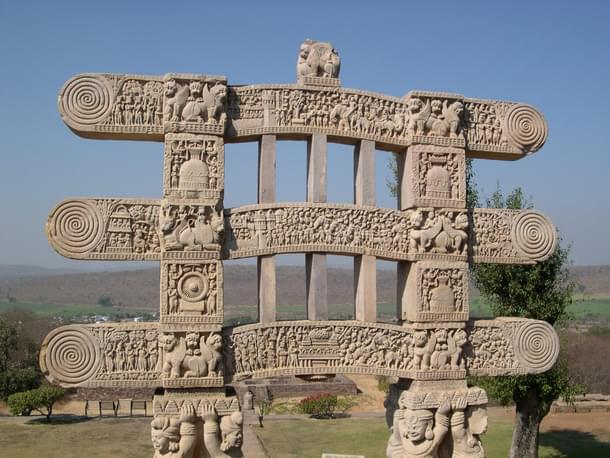
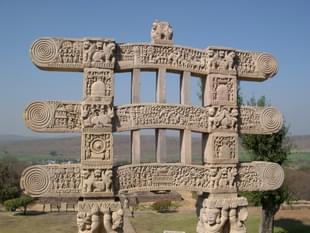
I am beginning to feel a bit like the captain of a warship. In the movies, you always see naval vessels firing upon each other fire first on one side of their target and then the other before hitting the enemy ship.
Similarly, over the past six months, I first visited Ladakh, the northern-most region of India, and then Kerala in the south before landing in Madhya Pradesh, the state whose tourism board uses geography to its advantage and advertises itself as the heart of India.
Madhya Pradesh is famous for its three UNESCO World Heritage sites – the Great Stupa at Sanchi, the Upper Paleotlithic rock paintings at Bhimbetka, and the erotic sculptures adorning the walls of the temples at Khajuraho. But more than that, the state’s reserve forests – Kanha, Bandhavgarh, Pench, and Panna to name a few – attract nature enthusiasts; for pilgrims, Madhya Pradesh offers Mahakaleshwar, Omkareshwar, and Amarkantak among others; history buffs have the forts of Mandu, Orchha, Jhansi, and Gwalior to hold their attention.
The way our trip had been planned meant that the starting point would be Indore. Instead of flying in, I thought I would use this opportunity to get better acquainted with India’s rail network – it is not that I have never travelled on it before but usually it was over short stretches such as Bangalore to Madras or Mangalore to Madurai.
I was told it would be an experience and indeed it was! When I tried to book my ticket, first, the website was down for maintenance. Then, their servers were too busy to handle requests.
I decided to download the Indian Railways’ mobile phone application and book my ticket through that but even that is apparently shut down at regular intervals to give priority to tatkal tickets. Eventually, the system broke me down and I had to approach a ticket sales agent.
The journey itself was not a civilised experience either. Even though I could access the First Class Waiting Room, other passengers were lying sprawled on the sofas, appeared unkempt, and some were even changing in public behind a pillar or with the help of a towel. First Class is clearly not what it used to be, a fact made even more poignant by photographs of the station from the 1930s on the walls.
I arrived in Indore early in the morning and I was off sight-seeing by noon. I had heard much about Indore, the home of Daly College. Unfortunately, the city did not live up to its hype. It was, I realised by the end of my trip, the liveliest city in Madhya Pradesh, but that was not saying much.
Our first stop was the Central Museum. I suppose it retains its name only by the grace of semantics, for it was a building with a shabby exterior and dull interior. Some of the artifacts on display, such as 1,700-year-old coins, were interesting but ruined by the lack of placards carrying information about the displays. For example, “coins” or “fossils” is hardly helpful. Furthermore, due to the poor lighting and glare from the glass cases, photography is difficult – I’d suggest that you save your money and not spring for a camera ticket.
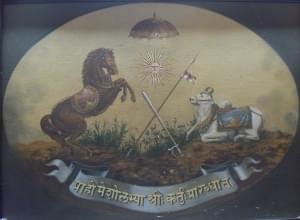
Our next stop in Indore was Lalbagh Palace. Built by Shivaji Rao Holkar in the 1880s, the 28-acre estate was completed in 1921 by his successor, Tukoji Rao Holkar III. Tukoji Rao Holkar III had three wives, one of whom was American Sharmista Devi Sahib Holkar (née Nancy Anne Miller), six daughters, and one son, Yeshwant Rao Holkar II, in whose favour the king abdicated his throne in 1926.
The Holkar estate was taken over by the government in 1978 after the death of Tukoji Rao Holkar III. Our guide said it was because the king had left no male descendents but it might well be the case that his survivors could not afford the estate duty. After the death of Yeshwant Rao Holkar II in 1961, his daughter, Usha Devi Holkar had to liquidate a sizeable chunk of the family assets to pay a whopping estate duty of Rs. 1.14 crores.
The palace reveals strong European influence on the Holkars, the interior decoration done mostly in baroque or rococo style and the architecture borrowing heavily from classical Greek styles; the gates of the estate were modeled on their counterparts at Buckingham Palace and were manufactured in England and imported to Indore; a statue of Queen Victoria adorns the gardens.
The Holkars of Indore are known particularly for their collection of jewels but this collection was dispersed a long time ago, first when the British forced Tukoji Rao Holkar III to abdicate over the Malabar Hill Murders, then the Government of India upon independence, and finally in a sensational jewelry heist in the 1990s.
The upkeep of Lalbagh Palace is quite poor – it is dusty and no thoughts have been given to illumination. There are few informational placards around the palace nor are there audio guides available; the barricades to parts of the building have been constructed without delicacy.
Despite this, the palace is worth a visit because the Holkars played an important role in Indian history until the Battle of Mahidpur in 1817 during the Third Anglo-Maratha War. The visit is more beneficial in conjunction with what would be our next stop, the Rajwada in the heart of Indore.
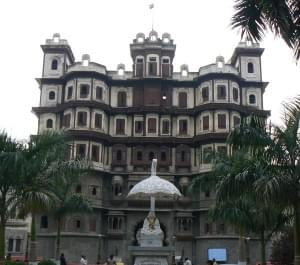
Rajwada is a seven-storeyed Holkar residence built in 1766 that today stands at a busy traffic circle in Indore. Our guide was not clear, who commissioned it or who oversaw its design but it was during the reign of Ahilya Holkar’s father-in-law, Malhar Rao Holkar, that the residence was built.
The vicinity used to have several Sikh businesses and sadly, part of the structure was burned down in the 1984 anti-Sikh riots of Rajiv Gandhi’s prime ministership. Rajwada is not quite in disrepair but it is poorly maintained. The renovations of 2007 by Usha Devi Holkar might have helped matters but there is still a long way to go in terms of making it an attractive stop for tourists.
Though the remains of the building itself are not particularly pleasing to the eyes, it was at the centre of Maratha power in northern India for 50 years. What I found interesting was the small and amateurish display of the history of the Holkar dynasty on the first floor to the left of the entrance. Unfortunately, the Holkars are not the subject of a plethora of scholarly tomes and I appreciated what little information I could glean from the exhibition.
For example, while the Anglicisation of the later Holkars was glaringly visible at Lalbagh, I was not aware of Tukoji Rao Holkar III’s promotion of education for women and support of other such social issues. The upper floors of Rajwada remain closed for tourists. As at the Central Museum, I found little use for my camera here.
In front of Rajwada is a traffic circle within which is a small park with a statue of Ahilya Holkar. Even from what little I learned of the Maratha queen, she came across as a smart and capable ruler who has not been given her proper place in Indian history books. In fact, I had not even heard of the Holkars in my ICSE high school in Udhagai.
Yet she won praise from her contemporaries as well as historians, who came after her; even her rivals and enemies acknowledged Ahilya Holkar’s wise rule. Although once cannot question the contribution of the Marathas and Ahilya Holkar in particular towards the renovation of hundreds of Hindu temples despoiled by Muslim rulers, once cannot credit them with much aesthetic sense.
Their renovations stand plain in comparison to the wondrous structures they sought to revitalise. To draw a feeble parallel for the Western reader or for those not acquainted with Hindu architecture, imagine that a wing of St. Peter’s was destroyed and it was renovated by a benefactor in Bauhaus style.
Our last stop of the evening was the Jain Kaanch Mandir. It was an unnecessary stop, I think, but it made the list because it features on several lists of things to see when in Indore. Nonetheless, a fact that struck me was that the Mahavira statue was black.
We had to call it quits after the Kaanch Mandir because of the time of the year – December – and it got dark by 1730 hours.
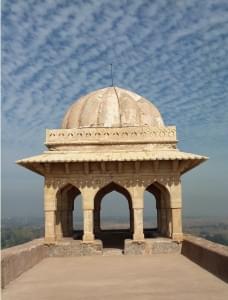
The next day, we headed to Mandu, about 100 kilometres to the southwest of Indore. The earliest references to this town tell us that Mandavgarh was a fortified settlement as early as the 6th century BCE. However, it rose to prominence under the Parmars during the 10th and 11th centuries.
A lot of the major attractions in Mandavgarh today, however, are of Islamic origin. This is because Allauddin Khilji captured the city in 1305 and it remained under Islamic rule until 1732 when the Marathas under Peshwa Baji Rao I took the city.
Our first stop in Mandu was the Mandavgarh fort, built in the 10th century by Raja Bhoj. The popularity of the fort, however, stems from the saga of a singer in Malwa, Rani Roopmati.
Apparently, Sultan Baz Bahadur of Mandu went out hunting once when he chanced upon a shepherdess singing in the woods with her friends. The sultan, a lover of the arts, was spellbound by her melodious voice and begged her to join him in his capital.
Roopmati agreed on the condition that she was never far from her beloved Narmada river. Baz bahadur agreed immediately and had the Rewa Kund built for her. The military observation post at Mandu fort – where Roopmati stayed – from which Baz Bahadur’s palace could be seen is today called Roopmati Pavilion.
As fame of Roopmati’s singing and beauty grew, the Mughal emperor Akbar became jealous that a minor king could possess such a treasure that the Mughal court lacked. He demanded of Baz Bahadur that Roopmati be sent to Delhi to grace the Mughal court with her singing.
When the sultan of Mandu refused, the Mughal emperor sent his general Adham Khan to emphasise his request. After a bloody battle at Sarangpur in which Baz Bahadur’s forces were defeated, the Mughal army went on a rampage in the town; thousands were killed with barbaric cruelty. The object of the invasion, Roopmati, evaded capture by consuming poison.
Some doubt this tale of love between the Muslim sultan and his Hindu mistress. Indeed, there are several similar stories told world over. The case of Madinat al-Zahra in the suburbs of Cordoba, Spain, comes most immediately to mind.
In any case, the romantic story gives Mandavgarh one of its key attractions in Roopmati Pavilion. To reach the observation post, there is a short yet steep path from where tourist vehicles are allowed to park. Alternatively, there are narrow steps that lead the way up. The pavilion is not inaccessible but older people and those with leg injuries will find it slightly challenging.
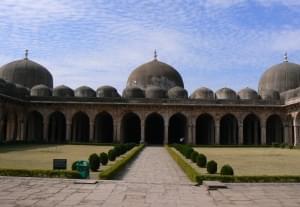
After Roopmati Pavilion, we moved on to Mandu’s Jami Masjid, completed in 1440 during the reign of Mahmud I. The layout is reminiscent of the simple Arabian mosques with their hypostyle worship halls and cloisters surrounding a courtyard in a geometric pattern.
The mosque is so bereft of adornment save its pleasing geometry that it does not even have a minaret. Unlike the Dilawar Khan and Malik Mughis mosques, the Jami Masjid retains a purely Islamic architecture as it was not built from Hindu temples and therefore avoids the corbelled arches and post and beam structure common to Hindu architecture.
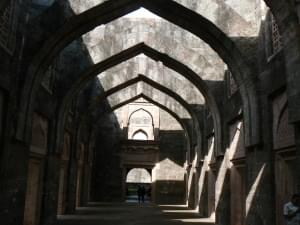
Our next stop was the Hindola Mahal. There is some debate about whether it was built in the beginning of the 15th century by Hoshang Shah or towards the end by Ghiyas al-Din. No matter, the building derives its name from its sloping walls which apparently give it the appearance of a swing.
Inside, the Hindola Mahal has a high and flat roof supported by five massive ogee arches. I was quite surprised by the thickness of the walls and the size of the arches. The structure follows the same look and feel of the Jami Masjid in that it derives its elegance from it clean lines and simple architecture, apparently the trend in 15th century Malwa.
The surroundings of the Hindola Mahal suggests that it was used as a pleasure palace; with the water bodies around it and the lawns, it would be a cool and relaxing place for the sultan and his harem to retire to.
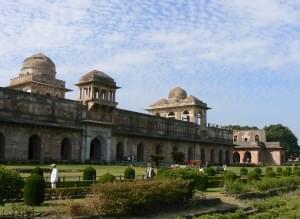
Right next to the Hindola Mahal is the Jahaz Mahal. ‘Jahaz’ means ship in Urdu and the reason the building is called so is that it is situated between two artificial lakes, giving its reflection in the waters the appearance of a ship on a moonlit night. While it is difficult to realise it in the dry season, the palace is located on a narrow strip of land between the Kapur Talao and the Munj Talao.
Unlike the Hindola Mahal, we are quite certain the Jahaz Mahal was built in the middle of the 15th century. Many uses have been ascribed to the building. While the guides at the site tell everyone the building served as the sultan’s harem, it has also been suggested that the palace served as a sarai, an inn, for travellers. Of course, nothing precludes the Jahaz Mahal from having been put to different uses under different administrations.
What struck me most was the museum, housed in the Taveli Mahal – admittedly by the grace of semantics – that I stopped by on my way out of the complex. Despite containing two Islamic buildings, the museum on site was filled with broken statues of Hindu gods and goddesses.
I asked our guide how this came to be, that a Hindu sculptures would be found strewn around a Mughal pleasure complex. He replied that some have suggested that much of the raw material that went into Islamic buildings was salvaged from captured and desecrated Hindu temples and palaces – the wood was destroyed but the stone could be reused.
This is not entirely unlikely when viewed in the backdrop of the Islamic treatment of dharmic shrines all over India but I have never heard this explanation for the structures around Mandavgarh. This question requires some more reading on my part.
There were a few other stops, we made in Mandavgarh – Echo Point, Ashrafi Mahal, Hoshang Shah’s tomb – but those were almost in passing. The first rule of the tourist’s handbook is that you cannot see everything in one trip – the sooner one makes peace with this fact, the sooner one will start enjoying one’s tours.
Furthermore, after catching the highlights of the town in the places we had already seen, only historians specialising in that region or local history aficionados remain interested in spending more time at all the other points. Thus, we called it a day after the museum at the Jahaz Mahal complex.
Day Three, whether by design or otherwise, turned out to be a day of pilgrimage. Madhya Pradesh is littered with temples, particularly to Shiva, and we visited one of the most sacred of those temples – the Mahakaleshwar Temple in Ujjain. Mahakaleshwar is the site of one of the twelve jyotirlingas and therefore considered to be a most holy place for Shiva worship. Predictably, it is a very crowded spot for devotees and tourists alike.
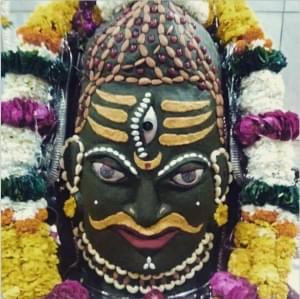
I know that one of the things one simply must do when visiting Mahakaleshwar is witness the bhasmaarti but that was going to be a bit difficult given our logistics – we were still camped out in Indore and planning on hitting Ujjain on the way to Bhopal.
The Mahakaleshwar temple structure itself was destroyed by the Islamic armies of Shams-ud-din Iltutmish in 1234 and rebuilt by a general of Peshwa Baji Rao in 1736, Raanoji Rao Shinde.
Due to the destruction and rebuilding, Mahakaleshwar does not offer much by way of aesthetic gratification as Chola or Hoysala temples might. Interestingly, the idol at Mahakaleshwar faces south, normally considered an inauspicious direction because that is where the abode of Yama lies. However, Mahakaleshwar, as the name implies, is the conqueror of Time itself.
We were very lucky in that the crowd thinned just as we got to Ujjain around ten though it became more crowded almost immediately after; we were not too far behind in the queue for regular darshan and we could even get into the sanctum sanctorum for worship.
You are not allowed to carry cameras or mobile phones into the temple – if you have them on you at the gate, you will be asked to return outside where a stall is provided for people to leave their footwear and valuables.
The priests at Mahakaleshwar are quasi-touts, scanning the crowds for devotees, who look wealthy and then offering them an opportunity to do an abhishekam of the lingam themselves for a fee. Apparently, I look like a wealthy foreigner and I was escorted through the crowd in the garbhagriha to the front to worship in ease and privilege.
After Mahakaleshwar, we went to the Chintaman Ganesh temple where the idol is swayambhu. One thing I will tell you about these swayambhu murtis is that they are, in essence, a three-dimensional version of a Rorschach test – one might as well see a replica of Q as of whichever deity is being claimed!
Chintaman Ganesh was also a victim of Islamic vandalism – the shikhara and domes are clearly more recent but the pillars in the temple date back to the 11th century to when the Paramaras ruled over Malwa.
Next, we visited Bada Ganesh, Gadkalika, Panchamukhi Hanuman, Harsiddhi Mata, and Kaal Bhairav temples in quick succession. Ujjain is a Shaktipeetha as well as the site of a jyotirlinga, so a Kal Bhairav temple can be found there too as per custom.
As per Hindu beliefs, the elbow of Sati fell in Avanti, as Ujjain was then known, after Vishnu’s Sudarshana chakra cut up her body (or the force of Shiva’s taandav disintegrated her body). The temple around where the elbow fell is the Gadkalika temple.
The Harsiddhi Mata Mandir is said to have been built by Vikramaditya, putting the date of the original temple somewhere in the first century BCE. Of course, the temple looks very new – one just has to accept large chunks of mythology when one goes to these places.
As every child knows, according to the Bhavishya Purana, Vikramaditya was supposed to be a great and wise king. His exploits as narrated in the Vetala Panchvimshati or Simhasana-Dwatrimshika make for instructive, thought-provoking, and entertaining reading. The ceiling in the Harsiddhi Mata Mandir really stood out for me. On it was a yantra surrounded by images of all the 64 yoginis.
The Kaal Bhairav temple where Hindus offer meat and alcohol to the deity was most interesting. The place is at the end of a long lane off the main road that is lined on both sides with stalls selling alcohol and other offerings that can be made at the temple.
At the corner, on the main road, is a police station, the Central Jail, and the residence of a couple of the top prison officials. The part where it gets interesting is that the sale of alcohol in India is regulated by a license, and none of these stall owners have licenses to sell the small – 180 ml – bottles of liquor.
Despite the police presence right next to the stalls, raids on these stalls are at infrequent yet predictable intervals. Talk about backs being scratched! The crowd, of course, was most uncivilised and entirely ignorant of advanced crowd organisation methods like queues.
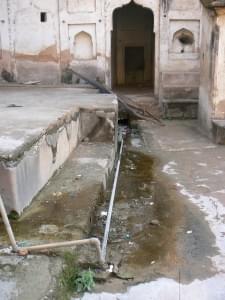
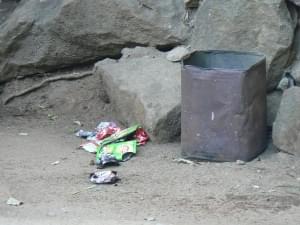
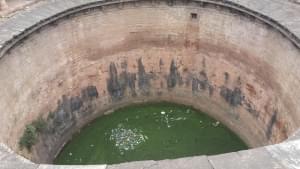
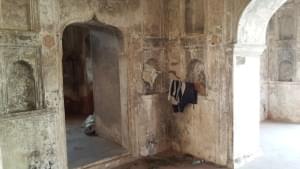
After lunch, we moved on to our last visit of the day – Sandipani Ashram – before heading towards the state capital, Bhopal. Legend says that Krishna, Balarama, and Sudama studied here under Rishi Sandipani.
I have no clue how the geolocation was done, via word of mouth, close scrutiny of ancient texts, or some other method. There is no modern scientific evidence for the claim as far as I know. In any case, I did not like the atmosphere at the ashram – rather than being a serene place of learning or even of worship, it had the feel of a cheap trinket being used to indulge people’s fantastic notions of the past.
As we drove around Ujjain from temple to temple, I could not help notice the state of the Ram Ghat on the Shipra river. Ujjain is one of the four places the Kumbh Mela is held, the other three being Allahabad, Nasik, and Haridwar, and in Ujjain, the Mela is held along the Ram Ghat once every twelve years.
The riverside is filthy, even our guide admitted, and yet one of Hinduism’s holiest festivals occurred on the spot amidst the filth. This was not an Indian problem – never have I seen a dirty gurdwara, for example, and no mosque, church, or synagogue come anywhere close to the filth around many of Hinduism’s holiest shrines.
We reached Bhopal in the evening as planned. Despite being the state capital, Bhopal seemed like a large yet sleepy town. Most of the town was dusty and littered, and the only nice parts of town I saw were, unsurprisingly, in the vicinity of the chief minister’s residence. I admit that a first and cursory glance at a town hardly reveals all, but as our local driver the next day succinctly explained, “भोपाल में वह रौनक नहीं है जो इंदौर मैं है।”
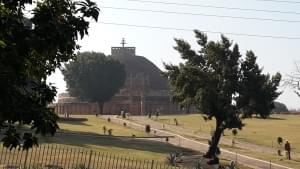
Early next morning, we set off for the first thing in our itinerary that I was excited to see – the Great Stupa at Sanchi, some 45 kms away from Bhopal. The Great Stupa is perhaps the oldest, surviving man-made structure in India. Built around the early 3rd century BCE by the Mauryan emperor Ashoka, the stupa holds the relics of Gautama Buddha.
Our guide suggested that the original stupa was badly vandalised and it was during Sunga reign that it was rebuilt and embellished. In fact, all the aspects of the stupa that attract the most attention today are later additions. For example, the three-tiered chhatra on top, the balustrade, and the toranas were all commissioned by the Sungas and Satavahanas a century or more after the original stupa had been constructed.
The small schools and monasteries around the stupa date back to the Gupta period. Sanchi was also the spot from where Ashoka’s son, Mahendra started his proselytising mission to Sri Lanka. By the way, it should be noted that Sanchi has no connection to Buddha – he was born in Lumbini and he attained nirvana at Bodh Gaya. Buddha did not even visit Sanchi.
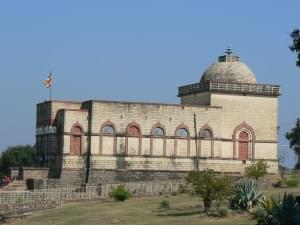
When one enters, the first structure one encounters is the Chetiyagiri Vihara. This structure is a Buddhist temple inaugurated in November 1952 and houses the remains of Buddha’s two principle students, Sariputra and Maudgalyayana.
Apparently, Buddha also had two principle female students, Khema and Uppalavanna: whether this symmetry was a later concoction or whether it was just coincidence is hard to tell with my superficial readings on Buddhism. Anyway, the remains of Sariputra and Maudgalyayana were placed in the Chetiyagiri Vihara after they were returned by Britain, where they had been sent after excavation from Stupa No. 3 at Sanchi by Alexander Cunningham in 1851.
This stupa still stands and is to the left of the Great Stupa as one enters from the north. Some of the remains were sent to Burma and Sri Lanka, where they were also enshrined. The holy relics are put on display only on the last Sunday of November every year because…the temple was inaugurated by Prime Minister Jawaharlal Nehru on November 29, 1952, the last Sunday of the month!
The temple is very clean and well-maintained. However, it does not come under Sanchi management auspices because the Great Stupa has been designated as a UNESCO World Heritage site since 1989. I am not clear whether the Mahabodhi Society of Ceylon manages the Chetiyagiri Vihara or only organises the annual festival.
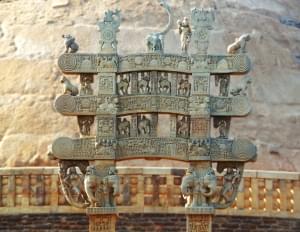
As one approaches the Great Stupa, one does so from the North Gate. This has the most famous torana, the one with the broken dharma chakra, the triratna, and other popular motifs. Since the torana was constructed before the era of murti puja in Buddhism, it is decorated with carvings of tales from the Buddha’s life and the Jataka Tales.
An interesting scene on the North Gateway depicts three foreigners worshipping the stupa. The load bearing elephants carved on the gateway used to have actual ivory tusks that were provided by ivory traders from nearby Vidisha during the reign of Ashoka. The oldest gateway, however, is actually the southern one. Near this gateway is a broken Ashokan pillar with the Schism Edict engraved in Prakrit.
The broken shaft of the polished pillar is kept a few feet back, in the shade, and its lion capital is in the small museum on site. The complete pillar weighs approximately 50 tonnes and was made from a single piece of stone transported from Mirzapur, nearly 700 kms away. The tragedy of the Ashokan pillar is that it was pulled down and broken by a local businessman to use as a sugarcane press.
There are similar carvings on the eastern and western toranas. The West Gate is famous for the four yakshas that bear the weight of the torana: each of them is in a different mood – happy, discomforted, sad, and angry.
The four are a metaphor for bearing the burden of life with the right attitude. Off the West Gate is also the monastery built by Ashoka’s wife. Along with the usual chambers for meditation, scholarship, and lodging, the monastery contained a large begging bowl in which monks were supposed to place all that they had received as alms; the food would then be shared equally by all residents.
Sanchi also has several inscriptions. Of course, dozens of stone slabs are marked with the names of wealthy patrons, who donated them but there are more substantial inscriptions on site as well beyond the “xyz danam” of the stones in the balustrade.
First, as already mentioned, is the Schism Edict of the Ashokan Pillar. Second, there is a detailed epigraphic record of the donation by the Gupta emperor Chandragupta II around the end of the 4th century. The third notable inscription dates to the 9th century and is the Sanskrit mantra, “Ye dharma hetu…”
Taken together, the inscriptions indicate that Sanchi was a thriving religious site for over a thousand years and offerings flowed from far and wide. The volume of epigraphy available at Sanchi helped James Prinsep to decipher the Brahmi script in 1837.
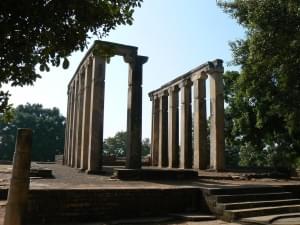
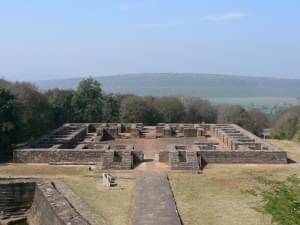
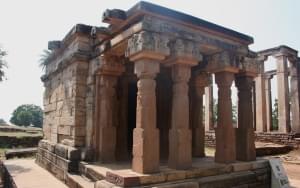
After the crowds of Ujjain, I was delighted to find Sanchi practically deserted; this allowed me ample time to walk around the site, poking at stones and peering at inscriptions, not to mention the taking of obligatory photographs for my various social media accounts.
We could not, to my great chagrin, visit the Heliodorus column at Vidisha. barely 10 kms from Sanchi, the famous column is the oldest record of a Westerner accepting the precepts of sanathan dharma, specifically Vaishnavism. We know this from the two Brahmi inscriptions on the pillar. Of course, there may have been many earlier Western converts to Hinduism but none as wealthy as the ambassador of Antiakalidas, the Greek king of Taxila, to the court of King Bhaghabadra.
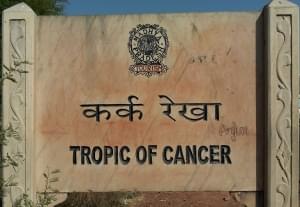
On the way back to Bhopal, we stopped by a marker that indicated the passing of the Tropic of Cancer through the region. Since it was just a day after the winter solstice, I couldn’t help but stop and take a photo of the marker.
In the evening, I wandered down to Bhojtal, the 31 km2 artificial lake built by and named after Raja Bhoj from whom both the city also gets its name. It still supplies almost half of Bhopal’s water needs. The lakefront is supposed to be prime property with the chief minister’s house a stone’s throw away, but there was still litter to be seen.
There is a statue of Raja Bhoj by the lake, as well as an old train I took to be a model until I saw all the placards and photos around it. The waterfront was a nice place to while away the short evening. We ambled about for a bit before taking a boat ride and heading back to our hotel.
We set off for the hill station of Pachmarhi the next day, planning to stop by the rock shelters of Bhimbetka. Discovered in 1957 by VS Wakankar, Bhimbetka was made a World heritage site in 2003. The place is absolutely fantastic if ruined somewhat by our cuckoo guide, who did not accept Charles
Darwin’s theory of evolution…keeping my mouth shut that day was the hardest thing I had ever done! He also seemed to be a proponent of a crude version of the Aryan Invasion Theory. I have my issues with that too, but there might be some merit to certain aspects of the theory.
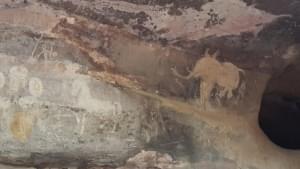
Homo erectus dwelled at Bhimbetka some 100,000 years ago and the site has remained occupied until recently. Paintings on the rocks of Bhimbetka date as far back as 30,000 years ago during the Upper Paleolithic era yet others are as new as the medieval era.
I was not aware of how recent some paintings were and I felt a lump form in my throat when I saw the first horse painting. False alarm! Scholars classify the paintings into seven periods. Approximately 750 paintings have been discovered on the rocks so far and some 450 are accessible via several pathways created by the Archaeological Survey of India for tourists. Due to the large time frame, it is important to have a good guide or guidebook with you when studying the artwork. Otherwise, you could jump to wrong conclusions!
The paintings show various phases of human existence – hunting, hunting large game in groups, advances in weaponry, social events, and other developments. The age can also be predicted by the nature of the artwork – different colours are used in different periods, and the method of drawing changes from linear to geometric and so on.
I think a full day is required at Bhimbetka but given our packed itinerary, we had to cut corners somewhere. By the way, Bhimbetka translates to ‘the seat of Bheema. It was believed that Bheema used to sit on these rocks during the Pandavas’ twelve years in the forest.
We reached Pachmarhi (3,600 ft) in the evening. Until then, the roads had been adequate but after Bhimbetka, things got progressively worse. Like so many hill stations in India, Pachmarhi was a filthy place with great potential. Your mobile phones will not work unless your carrier is Idea or BSNL though some of the guests at my hotel seemed to manage fine with Vodafone.
As far as I know, there are only two hotels in town and each is worse than the other. If you are travelling in a small group and need just a room or two, I strongly urge you to consider the several lodges available around town. The hotels, which I thought might have better service, are a nightmare. Those interested in planning a trip can look up my reviews on Trip Advisor.
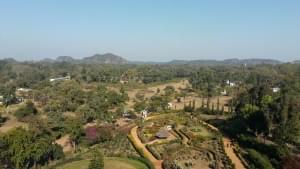
The next day proved to be a quasi-pilgrimage. We started the morning with the Pandav Gufa, which has nothing to do with the Pandavas. As our guide explained, Indians have a bad habit of associating anything that comes in pairs to Krishna and Radha, in threes to Ram, Sita, and Lakshman, and in sets of five to the Pandavas.
The five caves were in fact carved out by Buddhists around the 6th century as residences. The possibility of the caves being a place for worship is negated by the complete lack of any decoration. The Pandav Gufa offers little more than a picturesque view of the surrounding area.
Pachmarhi is in the verdant Satpura sub-mountain range, not a bad place if you’re into grass and trees. Parts of the Bollywood film, Ashoka were filmed in Pachmarhi and Bhedaghat.
Next, we went to Gupt Mahadev – basically a lingam installed at the end of a 20-foot crevice in a hill in 1967. Local folklore associates the region with the Bhasmasura incident and therefore people believe that the crevice is where Shiva hid from Bhasmasura as Vishnu readied himself to end the asura’s menace.
There was a small queue as only 10 people are allowed to go in at a time and you have to walk sideways into the crevice which is thankfully lit. People who had already gone in told me while I was waiting in the queue, “You feel…something inside.” I can now tell them that the word they are looking for is claustrophobic! I was taken in by the local advertising…totally not worth the time.
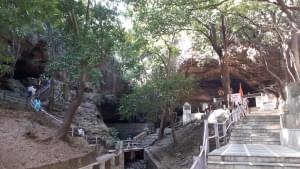
Right next to Gupt Mahadev is Bada Mahadev, a large cave with a lingam at the back. The cave was left completely in its natural state, including water dripping from the roof. I found this cave rather serene and liked it very much despite it being merely a hole in the wall.
Our guide – whom we had picked up from the Pandav Gufa – told us that the cave may have well been used as a temple for at least 1,300 years based on a trident found at the site. Pachmarhi is filled with tridents of all sizes. They are usually offered to Shiva as thanks for a wish fulfilled. This is particularly visible at Chauragarh, a Shiva temple atop the second highest peak in the Satpuras.
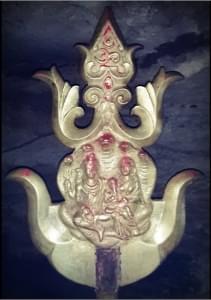
Beside the Bada Mahadev cave is Parvati Gufa, where I stopped in to say hello before heading to the next point on our itinerary, Handi Khoh. On the way, we stopped at Priyadarshini Point. Both Handi Khoh and Priyadarshini Point offer a great view of the valley and surrounding hills. Again, a place of interest for those into grass and trees.
By then it was time for lunch and we returned to the hotel as the roadside stands seemed shady to me. In the afternoon, we headed down to Jatashankar, another Shiva cave temple but at the bottom of a somewhat steep descent. Thankfully, some local benefactor had built steps – some 200 or so – all the way down.
The swayambhu lingam, was as I suspected, nothing more than a small stalagmite. Nonetheless, I was getting used to the idea that Pachmarhi was more about nature than history. Besides, there was a soothing air about Jatashankar that I liked very much. That air did not last long as a group of tourists hit the place and made more noise than a herd of stampeding buffaloes in the savannahs of Africa!
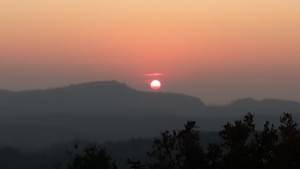
Our last stop in Pachmarhi was Rajendragiri, another middling peak from where one can see the sun set over the valley. It was just another sunset like any other day, I thought. But interestingly, the horizon was slightly higher than the mountain range and the sun seemed to set in the middle of the sky.
Early next morning, we left Pachmarhi for Bandhavgarh, one of the tiger reserves in Madhya Pradesh. However, the distance was a bit much for one day and we thought it would be wiser to stop in Jabalpur and complete the journey over two days.
It is 440 kms from Pachmarhi to Bandhavgarh but keeping in mind the roads of Madhya Pradesh and that we have to descend from a hill station, the journey would take some 10 hours. On the way to Jabalpur, we swung by the marble cliffs of Bhedaghat and Dhuandar Waterfalls.
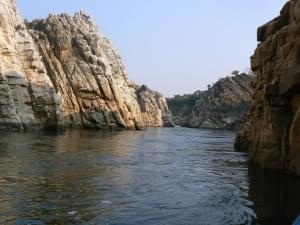
At Bhedaghat, the Narmada carves the soft marble and makes for a rather scenic stretch of about three kilometres. One of the songs from Ashoka was filmed here too. The area is famous for its marble artisans but that rock comes from a quarry inland and not the river bank.
We took a little cruise up the river in a rowboat to get a closer look at the marble formations but honestly, I just like being on water! The small town is surprisingly popular among Indian tourists, the Chaunsat Yogini Temple and Dhuandar Waterfalls being its other main attractions. The waterfall is barely 10 metres high and I am not sure what makes it such an attraction.
There is even a cable car that runs over it. The claim to fame is that the spray of water as the river drops ten metres looks smoky but then again, don’t all waterfalls have that effect? No matter, this was a far better stop to stretch one’s legs than a roadside dhaba.
The remaining part of our journey was completed the next day. I had thought that the roads were bad the previous day, but the last 15 kms or so to Bhandhavgarh took us about an hour and a half! We reached Bandhavgarh by afternoon and rested the rest of the day. In the evening, we sat about a campfire and watched some tribal dance our forest resort had arranged for. The show was amateurish and the lighting was plain idiotic.
The weather in Madhya Pradesh is usually pleasant in December but it is a little cooler in Pachmarhi and Bandhavgarh, the first because it is a hill station and the latter because of the thick vegetation that surrounds it.
This year, a cold wave was supposed to have been sweeping south from Delhi but it was still warm during the day (20° to 22° C) and pleasantly cool at night (3° to 7° C). Some, however, found the temperature unbearably low and were able to enjoy the campfire more than those who did not.
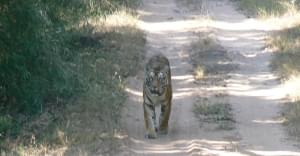
The thing about access to the Bandhavgarh National Park – I hear this is true for all parks – is that NGOs have truly poured sugar in the petrol tank on this. First, the nuisance bodies used the courts to have 80% of a national park declared off limits for tourists at all times.
With safaris only from 06 30 to 10 30 and 14 00 to 17 00, a very small window is available for tiger sightings as the jungle cats usually move and hunt at night. Between the inaccessibility and hours of operation, catching a glimpse of the majestic beasts has become more a matter of luck than anything else.
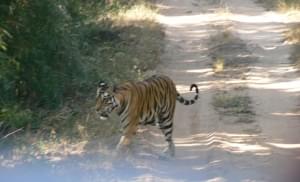
Second, in the name of animal safety, they have made the purchase of tickets so hard that many would be deterred by the effort. You can book your ticket online for Bandhavgarh but the dates are usually packed up to six months ahead of time. There is a small quota of tickets available for tourists, who visit more spontaneously but the queue for that is horrendous.
People stand in line from the previous night and when the ticket counter opens, there is a mad race from the gate to the counter. Only a few tickets are available for immediate access and that number depends on how many people, who booked online might have cancelled their plans. Finally, to buy a ticket, you need to fill out a form and have proof of identification. Mobile phones are not allowed inside the national park.
Third, the park officials are ridiculously strict with time – you have to reach the exit by the time given to you or they will shut the gates and leave. We ourselves had to make a mad dash for the exit, reaching just two minutes before the park closed for the afternoon.
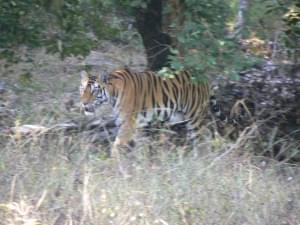
In fact, we were very lucky to spot a tiger. We had wound up our morning safari and were heading back to the gate in resignation when a new tiger mom just popped out ahead of us. By all predictions, the tigress should not have been out so late in the morning but here was that luck thing.
We hammered the brakes and skid to a halt, the driver furiously shushing the couple of ladies chattering away gaily in our jeep. From up ahead, another Gypsy approached and the idiots started yelling at us to give way! In the commotion, the tigress slunk back into the vegetation and I was left cursing the Bongs in the other Gypsy. Again, luck favoured us – after the other jeep went away, the tigress came out again, barely 10 metres from us, and for 30 seconds or so, allowed us marvel her gait and power.
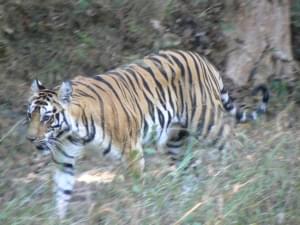
When the tigress disappeared again, we raced back before the officials locked us in or fined us. Bandhavgarh National Park is rich in other fauna too – we saw lots of spotted deer, which I guess is the main source of food for the tigers, and also some langur, rhesus macaque, sambhar, hawk eagle, lesser adjutant, and other animals. A group just ahead of us, we were told, spotted a black bear. However, it is the tiger that wins the prize for it is a rarer sight than the other animals in the national park.
Exuberant after our tiger sighting, we curled up before a campfire again in the evening. In the middle of nowhere, the sky sparkles a lot more and is much clearer than in hominid settlements.
The next day, we left for the famous Khajuraho temples. Due to some roadwork going on, the usual 250 kms became 300 kms thanks to a longish detour. In a normal country, this would take three hours to cover but in India, it took us some eight hours to reach our destination.

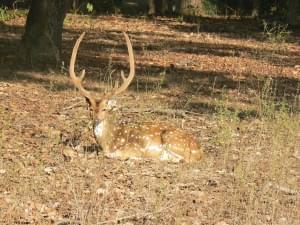
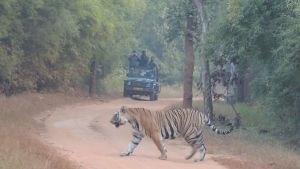
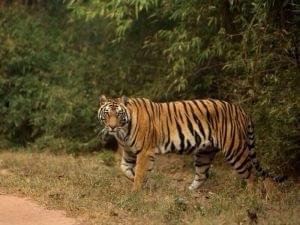
I should probably say something about regular Madhya Pradesh too, the parts that are not stunning monuments or national parks. The state is about half the size of France with a population slightly more than that of France. It did not take long for me to see why the state is considered a BIMARU state; even the capital resembled a sleepy interior town more than the seat of a state government.
Although stretches were decent, the general state of roads in the state is poor and there is no part I felt was clean. Food is a problem – restaurants are hard to come by once you leave major towns like Indore or Gwalior and the dhabas of Madhya Pradesh had me longing for the khanavalis of North Karnataka!
Toilets for women will be another problem tourists will have to consider while travelling in the state. My strong advice for non-Indians is that they find an Indian friend local to the region or a tour group that will take them around or do surgical strikes to selected hotspots like Khajuraho or Sanchi. Despite my litany of complaints against the state of affairs in Madhya Pradesh, everyone I talked to – cooks, drivers, porters, tour guides – told me that things have improved in the last ten years!
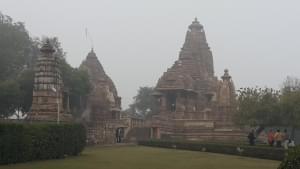
Khajuraho is a small town that barely has a metalled road. We reached Khajuraho late in the afternoon and the monuments had already closed. However, our hotel was barely a five-minute walk from the complex and I strolled over to get a glimpse of the next day. There are nice hotels in town but none are so close to the monuments – we took a calculated decision to prioritise proximity over comfort.
For that matter, Khajuraho is even served by an airport. It was difficult to see in the dark but the silhouettes of the temples stood out though they would not give me a clue about the wonder that awaited me the next day. The market was small but I found one small bookstore that allowed me to salivate and kill some time.
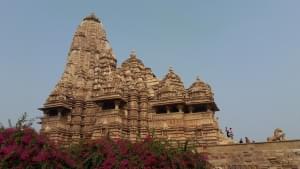
The next day, we visited the third highlight on my personal Madhya Pradesh wishlist – the Kandariya Mahadeva Temple Complex at Khajuraho. Let me just say that I was speechless; words could not describe my awe at the sight of the magnificent temples before me. The skies were overcast and fog was rolling in from the north so it was not ideal weather for photography.
However, little stood in the way of our observing the temples and their fine architecture. I was very pleased to note that audio guides were available in multiple Indian and foreign languages for a nominal fee at the entrance; I have always advocated this service so that tourists are not forced to hire unreliable and expensive guides. Of course, a guide adds a personal touch and that is what we went with at Khajuraho, but I was still pleased to have an option.
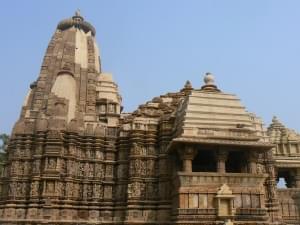
Of the 85 original temples at Khajuraho, 22 are still standing. They are divided into three groups, the Eastern, Southern, and Western groups. Only the Western group, consisting of the temples that adorn posters, books, and fertile imaginations, have the audio tour available.
Shaivism, Vaishnavism, and Jainism all found equal expression at Khajuraho. The Western group contains the famous temples of Lakshmana, Vishwanatha, Kandariya Mahadeva, Jagadambika, Chitragupta, and Chaunsat Yogini; the Eastern group is about two kilometres away from the Western group and contains the Jain Parsvanatha, Adinatha, Shantinatha, and Ghantai temples as well as the Brahma temple which is dedicated to Vishnu!
The Southern group is some five kilometres away from the Western group and consists of the Chaturbhuj, Duladeo, and Beejamandal temples though the latter has largely been destroyed. All the temples in Khajuraho face east except for the Chaturbhuj temple in the Southern group that faces west.
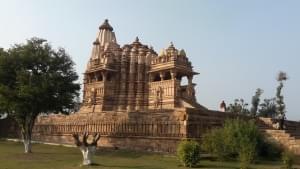
The poetic version of the origin of the temples goes thus: one day, a beautiful woman called Hemvati was bathing in a stream at night. Looking at her, Chandra, the Moon god, was overcome with desire for her. He descended to the earth and the couple spent a few happy days together.
Soon, Hemvati was with child. Worried about the stigma that would be attached to her and her child, Hemvati asked Chandra for a solution. The Moon god asked her to leave Benares and go to a forest of date palms to deliver the child.
He promised her that her son would be the first king of Khajuraho and be a great leader. Chandra told Hemvati to instruct her son to build the temples of Khajuraho so that she may be freed from the blemish of having an affair out of wedlock. Poetic perhaps, but it seems men still had all the fun.
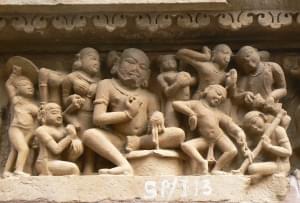
The historical version of the origin of the temples is that the Rajput Chandela dynasty built the temples of Khajuraho mostly between 950 and 1050. Most of the temples were built by the kings Yashovarman and Danga, though the largest temple, Kandariya Mahadeva, was built by King Ganda.
The name Khajuraho is thought to come from two golden date palms at the gate of the site that were missing at the time of the rediscovery of the site by English surveyor TS Burt in 1830s. Though famous for their erotic content, in actuality, such sculptures are quite few and no more than 15% of the total work.
The temple architects seem to have wanted to emphasise the purusharthas when building the structures for all activities of daily life are depicted on the wall, including sex. The panels show people drinking, dancing, apsaras putting on make up, wedding processions, going to war, musical concerts, attending school, and involved in the usual activities of life.
So contrary to the Western depiction of Khajuraho as a three dimensional sex manual for Indians, there are several subtler strands entirely missed by such superficial and even puerile observations.
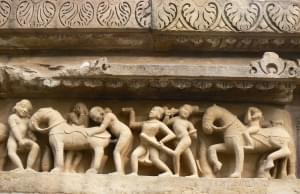
I was struck by the matter-of-factly way some themes have been suggested. In the middle of a section that depicts a military encampment and a battle, a small corner shows men having sex with animals. This has been an experiential reality of life that in situations where women are inaccessible or not present, men take recourse to other methods to relieve their desires.
However, such truth is usually politely ignored in public and it would have been scandalous to portray it in stone on a temple wall anywhere else. Khajuraho, however, leads in its boldness. However, as scholar Devangana Desai notes, despite all its forthrightness in the matters of the grihasta, one does not see a woman with multiple partners. Nor does one see partners of the same gender together.
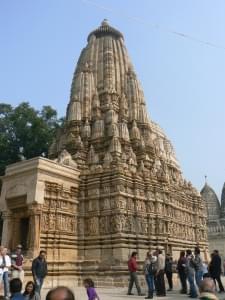
I could not stop taking photographs – every time I looked at a sculpture or a temple, I wanted to take another photograph. In my opinion, Khajuraho easily ranks alongside Belur, Halebid, and Ellora in aesthetic quality though I would still give Ellora top marks for the engineering of Cave XVI. Unwilling to take my eyes off the Kandariya Mahadeva Temple, I unwillingly left for the Eastern group of temples which are dominated by temples to tirthankaras.
The Jain temples are also magnificently decorated with sculptures but unlike the Hindu shrines, they are quite prudish. There is very little erotica on the Jain temple walls though there is some amount of hedonism. Part of the reason for the explicit nature of Khajuraho, our guide informed us, was the influence of tantric doctrines on the Chandela kings.
The Eastern and Southern temples of Khajuraho are included in UNESCO’s list of World Heritage sites. This is because a significant amount of renovation has been done on them and they are not true to their original form. The Shantinatha temple, for example, almost looks like a new temple.
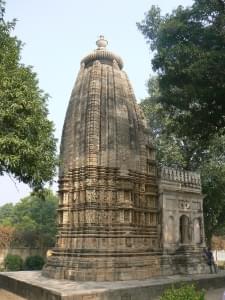
We could not go to the Southern group of temples because the road was so bad that vehicles could not access the latter half of it. However, the highlights include Chaturbhuj temple, which is the only temple at Khajuraho not to have any erotic sculptures on it and a much-renovated Duladeo temple that worships Shiva as a bridegroom.
There is also the half-excavated remains of the Beejamandal temple which is estimated to be even larger than the Kandariya Mahadeva temple in its complete form.
I have heard some interpretations of the erotica at Khajuraho a representation of divine love and not sexual in nature. All I can say to this exercise in intellectual gymnastics is that these are the wages of being colonised by an uptight, and prudish power caught in the throes of Victorianism.
While ancient and medieval Indians may not have been libertines, I wonder if they were as bashful as we pretend to be today. There is much evidence to suggest that they were not.
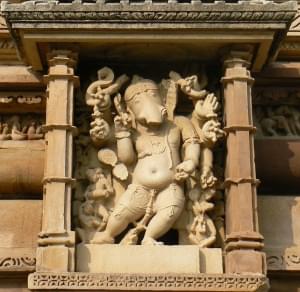
I went back to the Western complex after lunch to visit the Vishwanatha and Chitragupta temples that I had missed in the morning. The Vishwanatha temple was undergoing cleaning and was covered by scaffolding on one side. Opposite the temple was a Nandi temple. The Chitragupta temple was badly damaged and even large parts of its jagati had to be renovated.
Of course, the renovation work left a lot to be desired. I had time to pop into the Khajuraho museum where I was one of the best Dancing Ganesha statues I have ever seen. I just felt like setting up a chair in front of it and settling down with some samosas, kachoris, and tea to just stare at it.
Sadly, ASI does not allow photography in its museums. In the evening, we caught the light & sound show narrated by Amitabh Bachchan,
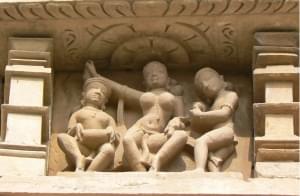
Barring Matangeshwara Temple, the other temples of Khajuraho fell into disuse by the end of the 12th century. Mahmud of Ghazni had mounted several unsuccessful raids of Kalinjar around 1022. He was unsuccessful but undefeated, and retreated only after being paid a huge sum of money by the Chandela king.
Khajuraho fell to Muhammad Ghori around 1202. Following his footsteps, Khajuraho was vandalised repeatedly by waves of Islamic invaders – Qutb-ud-din Aibak, Sikandar Lodi, and Aurangzeb. Some of this has been attested by historians and travellers such as al-Biruni and Ibn Battuta.
The only reason Khajuraho was spared further devastation was its relatively isolated location. For all those espousing a free market of religious ideals and the right to proselytise and convert, I suggest they visit the temples of Khajuraho, Ujjain, Ellora, Belur, Warangal, Hampi, Konark, Kashi, Halebid, and dozens of other places throughout India – they might find that there is a reason for the trust deficit in Indian society.

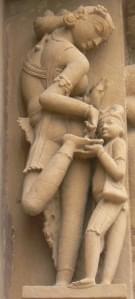
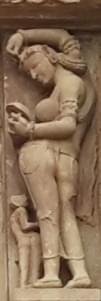
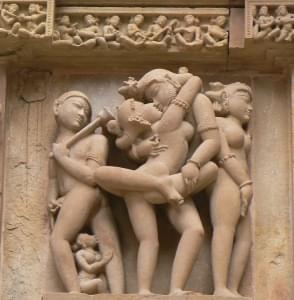
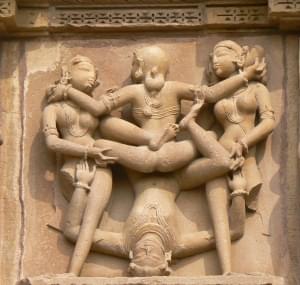
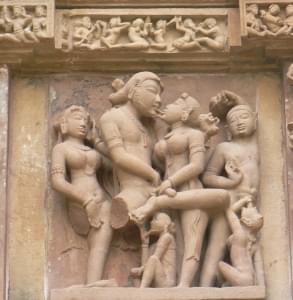

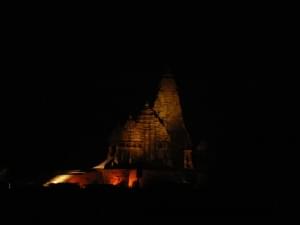
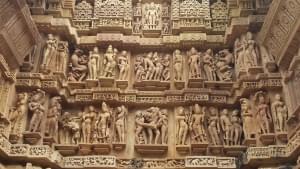
After Khajuraho, I was ready to go home. As someone wrote, क्यों न लूँ नाम-ए-खुदा इस बुत को देख के, लोग कहते हैं की मरने से पहले कलमा पड़ना चाहिये । However, there were a couple of days left to my itinerary and there was no way I was going back without visiting Orchha or Jhansi.
So that is where I headed the next day. Orchha was stunningly bad. Out of all the places I had seen on my trip until then, none was as horrible as Orchha. Don’t get me wrong – theoretically, the Jehangir Mahal and Raja Mahal are quite beautiful as is the Chaturbhuj temple, but in practice, I have seen better maintained buildings in wartime Kuwait!
The walls were covered with graffiti, people were throwing trash and urinating right outside the Chaturbhuj temple, and there was a broken pipe leaking dirty water in the Raja Mahal. In one room, someone had hammered a couple of nails in the walls and set up a clothes line!
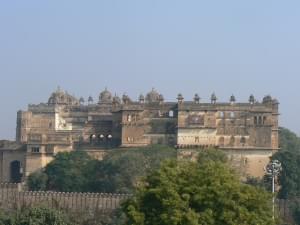
Orchha was founded in the 15th century by the Bundela king Rudra Pratap Singh and there is a lovely myth behind the founding that our guide was telling us but my mind was too frazzled by the shoddy upkeep of the monuments to take note.
The Raja Mahal palace is located exactly opposite the Chaturbhuj temple so that the first thing the queen saw upon waking was the Lord in the temple. There are a few murals that still survive and attest to what must have been a very beautiful palace overlooking the river. The palace is probably a perfect square and combines elements of Mughal and Hindu architecture in its lattice work and chhatris.
Jehangir Mahal is even bigger and more impressive but similarly ravaged by time and apathy. The palace is considered one of the finest examples of classical Mughal architecture. Sheesh Mahal, right next to Jehangir Mahal, is probably the newest structure on site and also the best maintained…because it has been converted into a hotel now.
The last of the mahals – Rai Praveen Mahal – is not strictly a palace like the first three but more of an elegant estate. It was the residence of the favourite mistress of one of the kings of Orchha and going by the property, he must have liked her very much.
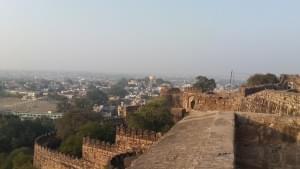
After the whirlwind tour of Orchha, we pressed on to Jhansi. We were told the story of Rani Lakshmibai of Jhansi, how she resisted the British and how she was eventually betrayed by her own in Gwalior. We saw the point were she jumped off the battlement and disappeared into the countryside to evade capture, the famous Kadak Bijli cannon, Lakshmibai apparently refused to fire at a temple, Company artillery had taken cover behind, and the joint mazar of Jhansi’s artillery commander Ghulam Gaus Khan, woman cannoneer Motibai, and cavalry commander Khuda Baksh.
Motibai’s cannon, Bhawani Shankar, is still in the fort though pulled back from its original position on the wall. There is also a Ganesha Mandir inside the fort as well as a Shiva temple – Jhansi was never meant to serve as a European keep and the king and queen did live there occasionally. Anway, the Ganesha Mandir looks rather new and I am not sure if it has not been touched up.
Our guide readily admitted that there were two versions of the firebrand queen’s story, the native version in which she fought a valiant struggle against the British, and the official version which borrows heavily from British views and sees the queen of Jhansi as a brave but foolhardy opponent of John Company.
It is very difficult, he said, to know which elements of the either version is true given the myth, secrecy, and paucity of records about Lakshmibai of Jhansi.
I was moved, however, by the recital of Subhadra Kumari Chauhan’s famous poem, झाँसी की रानी. After their victory, the British turned Jhansi fort into a prison and military camp. Crenellations were added; leisure areas were converted into water tanks, gun placements, or put to some other useful function; and chambers at ground level and below were converted into holding cells.
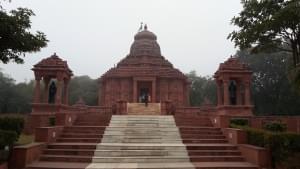
We reached Gwalior late in the evening. The 100 kms from Jhansi to Gwalior had taken us four hours to cover and we were tired from a particularly long day of travel and sightseeing. Gwalior was to be our last stop of the trip as it was a major railway hub as well as an airport for us to get out of town.
The next morning, we started our last day of sightseeing with a visit to the Birla Sun Temple. Like all Birla temples, it was a scenic and spiritually sterile spot. In a play on horological measurements, the temple is decorated with seven horses (days of the week), twelve wheels (months) on two sides for a total of 24 wheels (hours), and 365 statues (days).
I was tempted to ask what they do about the leap year but they probably keep an extra statue in the basement that is used once every four years just to snub curious and smart alec tourists like me!
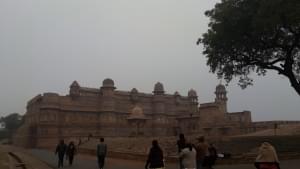
Our next stop was Gwalior Fort. This was a fairly different structure than Jhansi or Orchha because unlike the former, it was built more lavishly and unlike the latter, it was influenced by Hindu architecture and designs.
The fort sat on a peak, and along the road up to it, we saw several large tirthankara statues carved into the rock face. Some ofthe statues were pretty big, the largest one being some 12 metres high. That particular section of the slopes is called Gopachal Parvat. Inside the fort itself, there are several structures of interest – Man Mandir Mahal, Gurjari Mahal, Hathi Pul, Teli ka Mandir, and more.
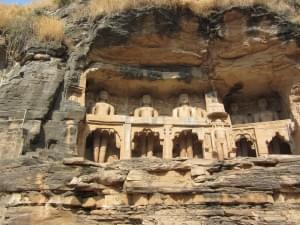
The fort goes back to at least the 8th century and has changed hands too many times for me to remember. However, despite periodic Islamic ownership, the place has retained many features of Hindu architecture. Though the Mughals destroyed a couple of temples in the fort, they left large parts of it intact and Hindu iconography can still be seen clearly on the walls as well as the building layout. The Mughals turned the fort into a prison for their political opponents.
For example, Akbar held and finally executed one of his cousins in Gwalior Fort. Aurangzeb put one of his brothers – Murad – to death in Man Mandir Mahal as well as his two nephews Suleiman and Sepher, the sons of Dara Shikoh.
The modifications to convert the palace for such purposes can still be seen; the queen’s jhula room, for example, was converted to a place where prisoners were kept chained to the ceiling and beaten. The other famous resident of the Mughal prison at Gwalior Fort was the sixth guru of the Sikhs, Guru Hargobind. A gurdwara exists within the fort as a memorial to him.
It is easy to get carried away in the more recent history of the fort and focus on Man Mandir but visitors should really make the effort to check out the older parts and artifacts of the fort – some structures such as the Sahastra Bahu and Shiva temples – together called the Saas-Bahu temple because the queen worshipped Vishnu and right next to her, the daughter-in-law prayed to Shiva – are almost a thousand years old. To be fair, both of these have been reconstructed in more recent times as the limestone wore away over the centuries.
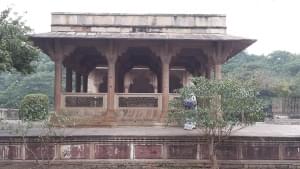
We headed to Tansen’s tomb next where I realised that for some reason, I had always thought the tomb of Muhammad Ghaus, a Sufi saint, to be that of Tansen. A small and unassuming structure, Tansen’s tomb is tucked away in a mausoleum complex dominated by Akbar’s last honour to Ghaus. As most people know, Tansen was born Hindu and started his music training under Swami Haridas but later came under the spiritual influence of Ghaus. Perhaps the amorphous mystical elements of Bhakti traditions and Sufism made for some easy cross-connections.
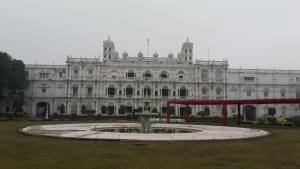
No one leaves Gwalior without visiting Jaivilas Palace, the residence of the Scindia family. Descended from the same line of rulers that betrayed Rani Lakshmibai of Jhansi, the Scindias are one of independent India’s political dynasties. I suppose the other way of looking at it is that they adapted with the times. When India gained independence, Jivaji Rao Scindia was appointed the governor of what was then Madhya Bharat. He died in 1956 but in 1962, his widow, Vijaya Raje Scindia, stepped into electoral politics by campaigning for and winning the Guna Lok Sabha seat on a Congress ticket. She later switched to the Swatantra Party and then to the Bharatiya Jan Sangh. Of her five children, her only son, Madhav Rao Scindia joined the Congress Party while two of her daughters, Vasundhara Raje and Yashodhara Raje, followed in their mother’s footsteps. Madhav Rao Scindia’s son, Jyotiraditya Scindia, has followed in his father’s wake and it is rumoured that his son, Mahanaryaman Scindia, is getting ready to follow in the same tradition.
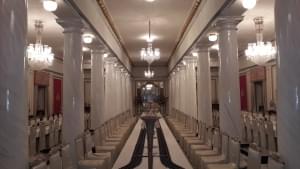
Jaivilas Palace is a very European palace. Despite a couple of paintings that pay lip service to the location of the palace, the inspiration drawn from the palace at Versailles is obvious. The furniture is also European and statues of Queen Victoria and British military officers still adorn the palace. Many of the themes that inspire the paintings and sculptures around the palace are drawn from European history and mythology; for example, there is a statue of Leda and the Swan that would most definitely be out of place in a more traditional Indian palace. There is also a table with inlaid pictures of Napoleon Bonaparte and his family. Jaivilas Palace was built in 1874 at a cost of ₹1 crore and contains 400 rooms. Its prime attraction is the pair of Belgian chandeliers that are estimated to weigh seven tonnes between them. The usual opulence of a palace is, of course, present. Camera tickets cost ₹70 but it is worth the price, I think.
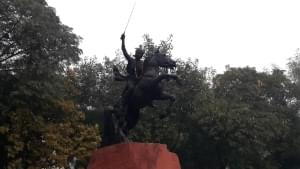
On our way back to our hotel, we passed by Phool Bagh, the little memorial to Rani Lakshmibai. It is not clear how the queen died: some say that she was killed in the fighting when the British 8th Hussars charged into the Indian forces at Phool Bagh as they were trying to leave the city while others say that Lakshmibai escaped the melee badly injured and asked a hermit in the countryside to cremate her remains so that the British would not be able to put her on display. A statue of the Queen of Jhansi has been installed and a clean park makes the spot a picturesque tourist spot.
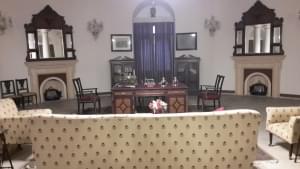
It was interesting to see how the Marathas and the other kings were thoroughly Anglicised over time. In the story of Madhya Pradesh alone, the two Maratha powerhouses of the region, the Holkars and the Shinde (Scindia), were initially fierce opponents of the British. As fortunes turned, it was only natural that their aggression become tempered but Indian nobility not only became subjects of the Crown but even their behaviour and tastes changed to include a very strong Anglicised streak.
Finally, after a long and hectic trip, I was headed back home. One last hurdle I had to manage was Indian Railways. The train was only 20 minutes late when it picked me up from Gwalior but was a full eight hours behind schedule by the time I had reached my destination. Furthermore, the train started up north and the entire North-South journey took it three days. I was on for only a day and a half but it takes very little time to realise how poor ventilated the compartments are. If someone has a jar of ill-prepared mesu pickle, the whole bogie will know very soon! I even spotted a cockroach scurrying away in the compartment. Traveling around India is an adventure sport in more ways than one and India’s Kachwa Rath does its bit to keep one guessing. I have always been an advocate of high speed rail, but the journey home made me an even stauncher supporter!
Despite this fairly long trip, there are still several places I missed in Madhya Pradesh – Omkareshwar, Amarkantak, Vidisha. Even at the places I alighted upon, there are places of interest I did not see, such as the Taj-ul-Masajid in Bhopal. And even in the places I did see, I wish I had more time in five or six places. Madhya Pradesh is a state rich in tourist attractions and any traveller must be clear what he wants to see before going there. I can easily imagine requiring two more vacations of this length to see the Central Provinces properly.
Despite the generally bad experience with hotels, roads, and food, I still think Madhya Pradesh is a province with stunningly beautiful things to see. For the rich and faint-hearted, there is always the air option to Khajuraho, Indore, Bhopal, or Gwalior. For others who want to enjoy the national parks, the hill stations, and the smaller towns that are as packed with historical buildings but receive less attention, tourism in India comes at a cost. Yet Madhya Pradesh is home to three World Heritage sites for a reason. I am not sure how long it will take for me to build up the courage to visit the state again, but I most definitely want to go back.
A few photographs…because I just couldn’t stop clicking on this trip
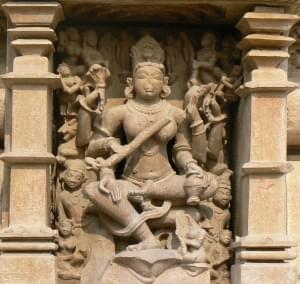
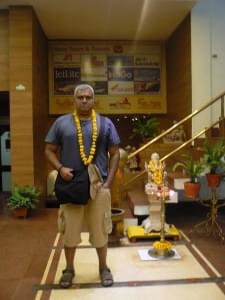
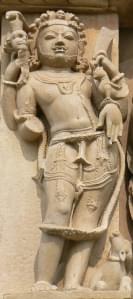
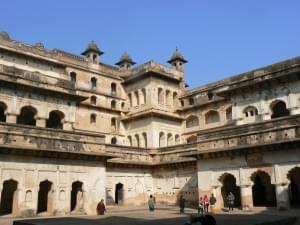
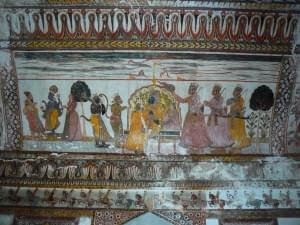
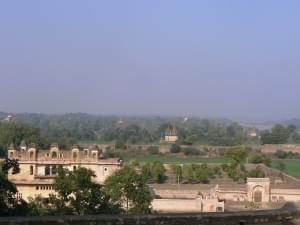
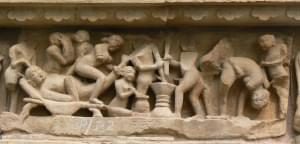
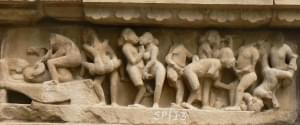
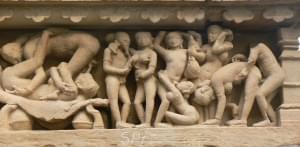
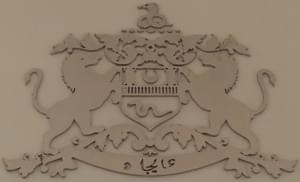
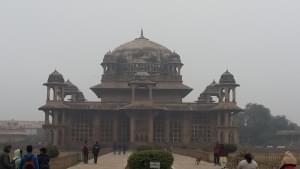
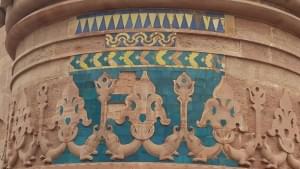
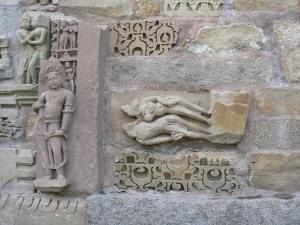
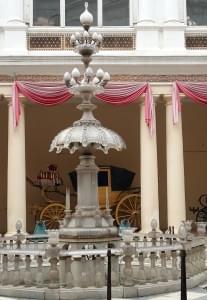
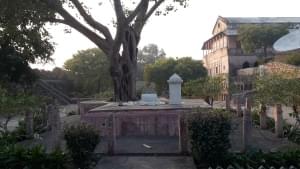
Jaideep A. Prabhu is a specialist in foreign and nuclear policy; he also pokes his nose in energy and defence related matters.





